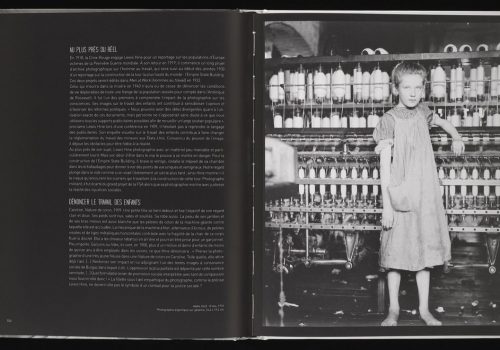The 20th century set the figure of the photographer center stage: it redrew its contours, pushed its limits, and redefined its tasks, propelling the new hero of the still image into the limelight. The photoreporter, the commercial or fashion photographer, the celebrity photographer, the war photographer, the corporate photographer, the society photographer: all these new types of photographer, including artist-photographer, came into their own in the twentieth century.
The volume Les Grands Photographes du XXe Siècle [The Great Photographers of the 20th Century], published by Larousse in the fall of 2017, tells the story of a century of images through fifty-six key photographers.
But what is a great photographer? “In photography, the concept of author has always been complex and porous,” explains Luce Lebart, the book’s author, for whom “great photographers are above all the groundbreakers of the visible.” While the notion of “great photographer” mustn’t be reduced to the question of style, it designates above all “those whose images and works have radically changed our ways of seeing and thinking about the world and images; those who have blazed new trails in the experience of, and experimentation with the visible, inevitably inciting us to see differently, to see more, and to appreciate what we see in new ways.”
These photographers have taken interest in things, people, and places that had long been neglected and under-represented. The introduction to the book offers a few examples: “This may be the outskirts of large cities, the zone that the French photographer Eugène Atget recorded in the early 20th century, showing for the first time images of suburbs, that is to say, places unlike those normally featured in popular, tourist, industrial, or heritage images. In a similar vein, the obsessive work of the German photographers Bernd and Hilla Becher focused on decrepit, abandoned industrial sites encountered by the roadside, turning them into archeological monuments, invaluable and endangered witnesses of a bygone era. By building a pictorial catalogue of thousands of these vestiges of industrial architecture and thereby constructing a repertory of forms, they have created a visual alphabet that earned them a sculpture award. For her part, the American photographer Nan Goldin has broken down the boundaries of intimacy, paving the way for many contemporary approaches. ‘There is no separation between me and what I photograph,’ she explains. She is seized with a pressing desire to capture every trace of passing life, and her camera is her “memory substitute.” Through both the subjects she photographs and the amateur-like technique she uses, her oeuvre is akin to a family album, but an album in reverse: the images she shows are those one tends to hide. They speak of suffering, solitude, separation, dependency, sexuality, or isolation. They document the blunt, daily reality which, however, because it is taboo and undermines social and visual conventions, has long eluded the accepted register of self-representation.”
Their names are Walker Evans, Dorothea Lange, Henri Cartier-Bresson, Philippe Halsman, Robert Mapplethorpe, Seydou Keyta, and Raymond Depardon. They brought the 19th century to a close and opened the 20th by fixing now-immutable colors. By capturing the moment, a split second, a glance, they have disrupted photographic art and forever changed how we look at the world and things. Witnesses to History, social revolutions, hardships, human suffering and tragedies, as well as to the beauty of living beings and the elements, their images have now become iconic.
On the pages of this lavishly illustrated book we encounter fifty-six of those great photographers, from Man Ray to Nan Goldin. We discover their personal paths and artistic careers as well as interpretations of an emblematic work accompanied by a note on the photographing technique. The volume is an invitation to delve into and relive their struggles, their pluck, and their fresh way of looking at people and the world in order to change how we think about images.
Luce Lebart is a historian of photography and an exhibition curator, as well as author of numerous books and articles, including Les Silences d’Atget and Lady Liberty. Director of the Canadian Photography Institute at the National Gallery of Canada since 2016, she had previously headed the Société Française de Photographie in Paris.
Les grands photographes du XXe siècle
Published by Larousse
€29.95
http://www.editions-larousse.fr/les-grands-photographes-du-xxe-siecle-9782035929112
















